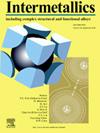Effect of external stress on the high-temperature corrosion behavior of GH4169 alloy
IF 4.3
2区 材料科学
Q2 CHEMISTRY, PHYSICAL
引用次数: 0
Abstract
The influence of the applied tensile elastic stresses on the corrosion behavior of GH4169 Ni-based superalloy, 75 wt% Na2SO4 + 25 wt% NaCl salt, 650 or 850 °C and 24 h, is investigated. The corrosion surface tend to exhibit serious peeling of the oxide scale and uneven morphology when stress applied, and the main corrosion products are identical with or without stress. With the increment in stress, the corrosion layer deepens, and more voids (or cracks) can be observed and their distribution as a function of stress and corrosion depth is further discussed with respect to linear density. Apart from the transverse extension of the corrosion area from grain boundaries to grain interior, the stress enhanced corrosion also demonstrates longitudinal extension along grain boundaries perpendicular to the stress direction into the alloy interior. Local mechanical properties in thermal etched region obtained by nanoindentation demonstrate that the alloy yields worse properties resulted from the negative effect of high stress and hot corrosion on internal microstructure. The mechanism of stress enhanced hot corrosion is further analyzed combining both experimental and molecular dynamics simulation results with respect to vacancies, distribution and bonding situation of atoms, and morphology and thickness of the transition layer.
外应力对 GH4169 合金高温腐蚀行为的影响
研究了在 75 wt% Na2SO4 + 25 wt% NaCl 盐、650 或 850 °C 和 24 小时条件下施加拉伸弹性应力对 GH4169 镍基超级合金腐蚀行为的影响。当施加应力时,腐蚀表面会出现严重的氧化鳞片剥落和不均匀形貌,主要腐蚀产物在有应力和无应力时相同。随着应力的增加,腐蚀层加深,可以观察到更多的空隙(或裂缝),并进一步讨论了其分布与应力和腐蚀深度的线性密度关系。除了腐蚀区域从晶界向晶粒内部横向扩展外,应力增强腐蚀还表现为沿垂直于应力方向的晶界向合金内部纵向扩展。通过纳米压痕测试获得的热蚀刻区域的局部力学性能表明,高应力和热腐蚀对内部微观结构的负面影响导致合金的性能变差。结合实验和分子动力学模拟结果,进一步分析了应力增强热腐蚀的机理,包括原子的空位、分布和结合情况,以及过渡层的形态和厚度。
本文章由计算机程序翻译,如有差异,请以英文原文为准。
求助全文
约1分钟内获得全文
求助全文
来源期刊

Intermetallics
工程技术-材料科学:综合
CiteScore
7.80
自引率
9.10%
发文量
291
审稿时长
37 days
期刊介绍:
This journal is a platform for publishing innovative research and overviews for advancing our understanding of the structure, property, and functionality of complex metallic alloys, including intermetallics, metallic glasses, and high entropy alloys.
The journal reports the science and engineering of metallic materials in the following aspects:
Theories and experiments which address the relationship between property and structure in all length scales.
Physical modeling and numerical simulations which provide a comprehensive understanding of experimental observations.
Stimulated methodologies to characterize the structure and chemistry of materials that correlate the properties.
Technological applications resulting from the understanding of property-structure relationship in materials.
Novel and cutting-edge results warranting rapid communication.
The journal also publishes special issues on selected topics and overviews by invitation only.
 求助内容:
求助内容: 应助结果提醒方式:
应助结果提醒方式:


